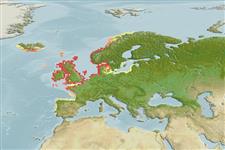Common names from other countries
Environment: milieu / climate zone / depth range / distribution range
Écologie
marin démersal; océanodrome (Ref. 51243); profondeur 17 - 22 m (Ref. 57178). Temperate; 72°N - 38°N, 25°W - 22°E
Northeast Atlantic: Lisbon north to Finnmark, around the British Isles, in the Skagerrak and Kattegat and Iceland.
Taille / Poids / Âge
Maturity: Lm ? range ? - ? cm
Max length : 25.0 cm TL mâle / non sexé; (Ref. 1371); common length : 17.0 cm TL mâle / non sexé; (Ref. 1371); common length :20 cm TL (female); âge max. reporté: 3.00 années (Ref. 1371)
Épines dorsales (Total): 0; Épines anales 0. Head relatively small, more than five times in SL. No lobed fold of skin above the upper lip. First fin ray followed by a row of small, fleshy filaments. Dark brown dorsally, reddish to blackish grading to pale gray-brown ventrally (Ref. 1371). One barbel on the lower jaw and four on the snout (Ref. 35388).
A resident intertidal species with homing behavior (Ref. 32612). Generally close to the shore, not descending to great depths beyond the limits of the distribution of green algae (20 m), preferring rock bottoms but also living on sandy, muddy, and shell gravel bottoms. Feed mainly on crustaceans, sometimes also on algae, polychaetes, gastropods and occasionally, small fish. Occurs in temperatures ranging from 8 to 24°C (Ref. 4944).
Eggs and larvae are pelagic.
Cohen, D.M., T. Inada, T. Iwamoto and N. Scialabba, 1990. FAO species catalogue. Vol. 10. Gadiform fishes of the world (Order Gadiformes). An annotated and illustrated catalogue of cods, hakes, grenadiers and other gadiform fishes known to date. FAO Fish. Synop. 125(10). Rome: FAO. 442 p. (Ref. 1371)
Statut dans la liste rouge de l'IUCN (Ref. 130435)
CITES (Ref. 128078)
Not Evaluated
Menace pour l'homme
Harmless
Utilisations par l'homme
Pêcheries: commercial
Plus d'informations
RéférencesAquacultureProfil d'aquacultureSouchesGénétiqueElectrophoresesHéritabilitéPathologiesTraitementMass conversion
Outils
Articles particuliers
Télécharger en XML
Sources Internet
Estimates based on models
Preferred temperature (Ref.
115969): 8.4 - 11.8, mean 10.3 (based on 52 cells).
Phylogenetic diversity index (Ref.
82804): PD
50 = 0.6250 [Uniqueness, from 0.5 = low to 2.0 = high].
Bayesian length-weight: a=0.00537 (0.00278 - 0.01038), b=3.10 (2.93 - 3.27), in cm Total Length, based on LWR estimates for this species & (Sub)family-body (Ref.
93245).
Niveau trophique (Ref.
69278): 3.5 ±0.3 se; based on diet studies.
Résilience (Ref.
120179): Haut, temps minimum de doublement de population inférieur à 15 mois (tm=1; tmax=3; Fec=9,000-30,000).
Fishing Vulnerability (Ref.
59153): Low vulnerability (15 of 100).
Climate Vulnerability (Ref.
125649): Low to moderate vulnerability (35 of 100).
